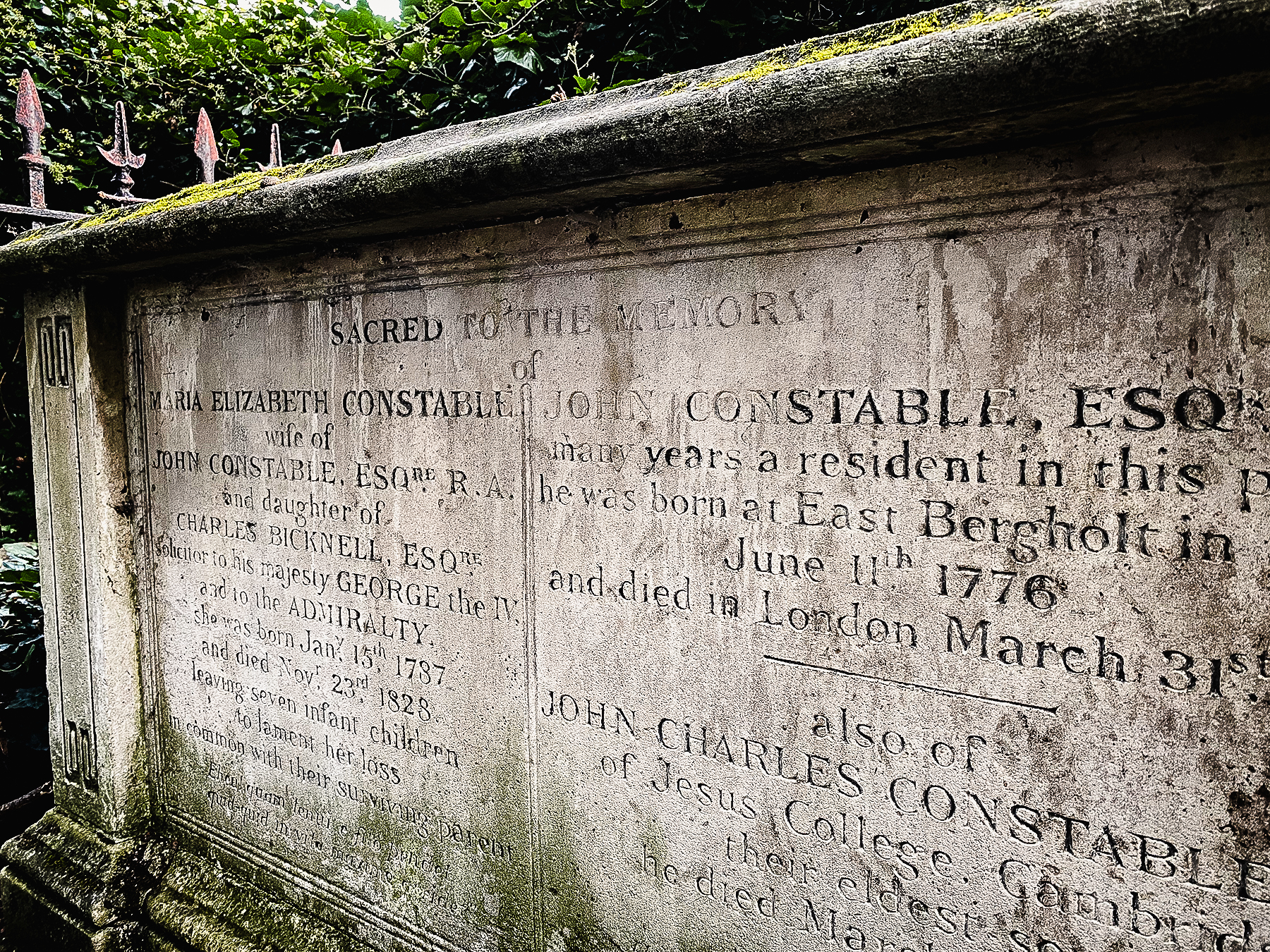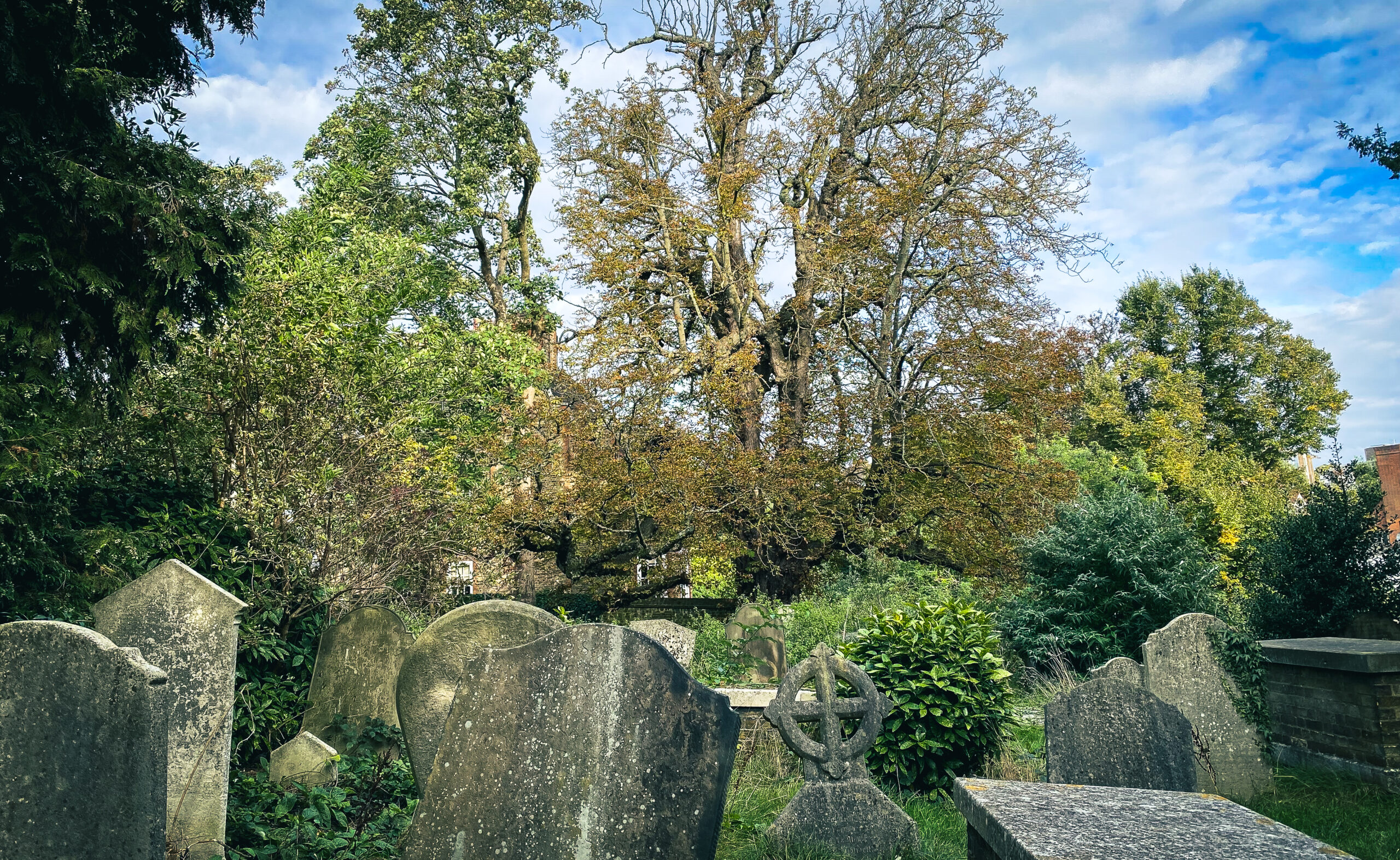I walked into a John Constable landscape and found hope – in a cemetery.
A bit tired of seeing tourist sights on a recent vacation, my wife and I took a Saturday to explore Hampstead in north London. We’d been here in 2015 for a guided walk about the poet John Keats. Walk, perhaps, isn’t the right word. It was more of a brisk run up and down the hills of Hampstead.
One place I wanted to see during this visit was where our Keats Walk had started – St. John-at-Hampstead Church, also known as the “Keats Church,” even though it was the family of his love interest, Fannie Brawn, who were members. Keats himself never attended. The church does have, however, a bust of the poet.
Unfortunately, the church was closed and locked for the day. A few people were walking by; a couple sat talking on a bench. Instead of leaving, we wandered around the churchyard and its cemetery. The original cemetery is adjacent to the church; a larger and newer extension is across the street.
If I’d been expecting a neatly trimmed and manicured landscape, I picked the wrong place.
A bit eerie even in daytime, the cemetery was overgrown with trees, bushes, and even weeds. The paths and benches were maintained, but not much else. Tombstones were tilting and falling over, with fading, hard-to-discern inscriptions and lichens on many of them. This seemed more like something out of Charles Dickens; I almost expected to see Pip meeting the convict of Great Expectations.
The benches allow you to sit and ponder. Or just sit. This graveyard achieved something almost impossible in London: silence.
The graves included a few well-known people (or at least well-known to locals). Perhaps the most famous cemetery residents were the Romantic painter John Constable (1776-1837) and his wife Maria (1787-1828). Their gravesite includes a memorial monument; it also noted one of their sons, John Charles Constable, who died four years after his father. (Apparently, the son wasn’t buried here.) The grave and monument were surrounded by a wrought-iron fence.

I stood by the grave for a time, thinking about Constable. His art revolutionized landscape painting. In his hands, landscapes became less formal and more untamed, much in keeping with the Romantic spirit of his adult years. This was the age of Francisco Goya, J.M.W. Turner, Eugene Delacroix, and William Blake, among other artists, and William Wordsworth, Percy Bysshe Shelley, George Lord Byron, and John Keats among the poets. Constable’s art exactly fit the Romantic times. (If you’re interested, one of the best introductions I’ve found to Constable and his art is the catalog for the 2014 exhibition at the Victoria & Albert Museum in London, John Constable: The Making of a Master.)
The temptation of standing at the tomb of a famous person and thinking “vanity, vanity, all is vanity” was almost impossible to resist. I succumbed, thinking this was where we all end up, no matter how famous. It was an indulgence, and it was also rather depressing for someone who’s already lived beyond his Biblical threescore and ten.
Then I paid attention to what was around me.
I could see other graves, to be sure, but the landscape of the cemetery strikingly resembled a Constable artwork. It felt like I had walked right into one of his paintings. And while a cemetery was obviously about death, the church, still a going concern after hundreds of years, was keeping watch over the graves and the landscape.
This was the story here, I thought. The church endured. Perhaps not the physical building, but the church as God defined it. It endured. This cemetery was a place where people could visit and sit, if they wanted, absorbing the silence and almost wildness of old trees and overgrown bushes. If they sat long enough, they might also see the hope here.
A cemetery reminds us of the transience of life, that we are here but a short time to do what God has designed us to do. It may be to paint wonderful works of art, or produce great literature, or save lives, or invent great things, or operate a business, or drive a delivery truck, or raise a family. No matter what our purpose, our lives as Christians are built upon faith and hope, the hope of heaven and the promise of God. Because of that hope, we are to do our work well, fulfilling what God has created us to do.
Our physical lives may end in a place like this cemetery at St. John-at-Hampstead Church. But this is not the end of our stories. A cemetery is more like the beginning of eternity.
![]()
Editor’s note: For a poetic reflection of another cemetery in England, read Nicole Howe’s, A Spell in Holywell.
The featured images are courtesy of Glynn Young and are used with his kind permission for Cultivating.
Glynn Young wrote his first story when he was 10 – a really bad mystery having something to do with a door behind a grandfather clock and a secret cave. At 14, he discovered Great Expectations by Charles Dickens, but he secretly wanted to write James Bond stories. At 21, he became a Christian, and the verse he was given, Philippians 1:6, became the theme of his life.
He received a B.A. in Journalism from LSU and a Masters in Liberal Arts from Washington University in St. Louis. He spent his professional career in corporate public relations, and mostly executive speechwriting. Since 2011, he’s published five novels in the Dancing Priest series and the nonfiction book Poetry at Work. Since 2009, he’s been an editor for Tweetspeak Poetry, writing a weekly column. He and his wife Janet live in suburban St. Louis.
Leave a Reply
A Field Guide to Cultivating ~ Essentials to Cultivating a Whole Life, Rooted in Christ, and Flourishing in Fellowship
Enjoy our gift to you as our Welcome to Cultivating! Discover the purpose of The Cultivating Project, and how you might find a "What, you too?" experience here with this fellowship of makers!


I can’t imagine what a moving experience standing in such a cemetery would be!! I Will think of this line today as we lay my 85 yr. old uncle (so ready to meet His Saviour)
to rest in a rural Ont. graveyard! ‘The temptation of standing at the tomb of a famous person and thinking “vanity, vanity, all is vanity” was almost impossible to resist.’ And the thoughts in the last paragraph are a great reminder to keep us grounded in our day to day activities!